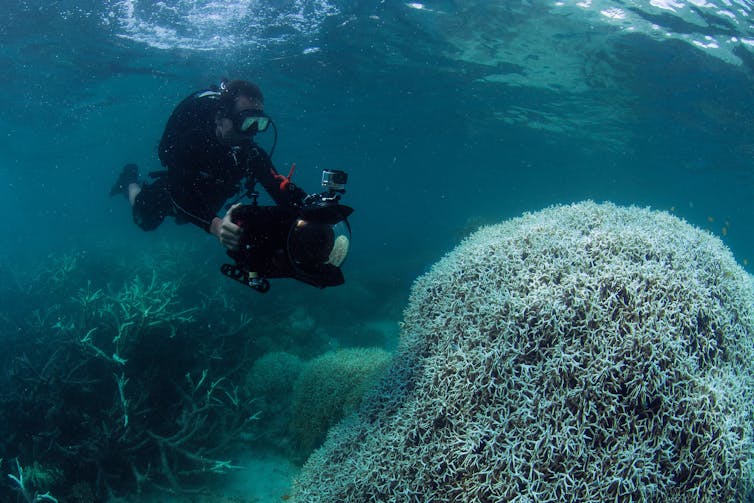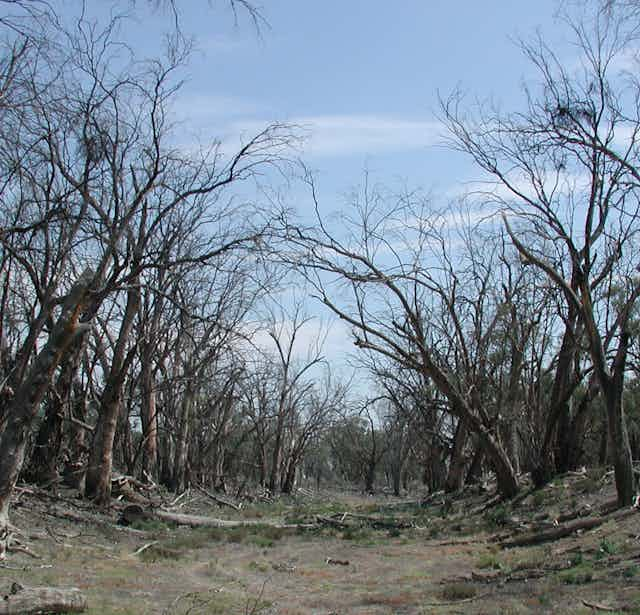Media reports around the world have brought the mass coral bleaching of Australia’s Great Barrier Reef into people’s offices and homes.
With 93% of individual reefs showing bleaching, the devastation among researchers, celebrities and the public is palpable.
Unfortunately, mass coral bleaching is just one example of a far broader problem. Although it represents a rapid and extensive example of ecosystem degradation, coral bleaching is not surprising: it is consistent with many changes that are occurring now across Australia’s natural environments.

The degradation and death of forests
Forest dieback is increasingly common across Australia from the high country and the floodplains to the savannahs.
Our iconic trees – including the world’s tallest flowering plant, the Mountain Ash, and the most widely distributed eucalypt, the River Red Gum – are among the hardest hit.
A stark example is the floodplain forests of the Murray-Darling Basin. Reduced rainfall and water extraction for human needs have deprived River Red Gums of the flooding integral to their existence. The consequence is that 79% of forests on the Murray River have dieback. Tree graveyards are a common sight.
Recent extreme weather combined with recurring wildfire and intensified logging has increased mortality rates of large, old Mountain Ash trees by an order of magnitude. This has created a crisis for the animals that depend on them, including the critically endangered Leadbeater’s Possum.

The plight of these forests foreshadows the fate of others (such as Western Australia’s Jarrah forests) under a drying climate.
The decline of south-eastern Australia’s frogs
Australia’s record-breaking Millennium Drought hit frog communities very hard. They have not recovered since.
It was hoped that the heavy rainfalls from late 2010 to early 2012 (the “Big Wet”) would help the frogs “bounce back”, given their capacity to lay large numbers of eggs under suitable conditions.
Modest improvements at the time of the Big Wet were undone with a return to dry conditions. These pushed the frogs back to the dire levels seen during the peak of the drought.
Species whose calls will be familiar to many Australians — the “crick-crick” of the common froglet, the “plonk-bonk” of the pobblebonk — saw very little post-drought recovery.

Long dry periods are expected in the region under climate-change models, so the prospects for southeastern Australia’s amphibians seem bleak.
The unravelling of Australia’s mammals
Australia has a remarkably distinctive mammal fauna. However, 30 mammal species have become extinct in the past 200 years. That’s an extinction rate worse than any other country.
Particularly disconcerting is that losses are continuing at an unabated rate, with two Australian mammals lost forever in the past decade.
In much of Australia, particularly in northern Australia, many native mammals that were abundant 20 years ago have become vanishingly rare.
The collapse of bird communities
The Millennium Drought also pushed bird communities of southern Australia over the edge.
On the back of historic declines (primarily due to land clearing), two-thirds of species declined substantially as the drought took hold. The assumption, or perhaps hope, was that these declines were part of a natural cycle, and that the drought’s end would bring a return to normal. This did not happen.
At last count, half of the species — including iconic species like galahs, rosellas and fairy wrens — were still far less common than they were before the drought.

The result is that our bird communities have dramatically changed in as little as two decades. As we enter another period of drying, there is grave concern about the future of southern Australia’s birds.
What do Australians value?
These are just a few examples of massive ecosystem degradation. Sadly, there are many more. The battle for Australia’s biodiversity can still be won, but this requires decisive action on climate change and serious investment over many election cycles.
In 2013, Australia ranked among the 40 most underfunded countries for biodiversity conservation, a list otherwise dominated by developing countries.
The budget allocation for the federal Department of the Environment is shrinking and is now less than 0.5% of the government’s spending. It is hard not to draw comparisons with the recent announcement that Australia will spend A$50 billion on submarines.
By contrast, avoiding extinctions of Australian birds would cost around A$10 million per year — a cost we are, at the moment, unwilling to meet.
US Vice President Joe Biden famously said:
“Don’t tell me what you value; show me your budget, and I’ll tell you what you value.”
On May 3, Australia’s government will present its 2016 budget and, with an election looming, we will also soon learn about the opposition’s spending commitments. The coming months will expose how major parties value Australia’s environment, and the election to follow will measure the degree to which Australians accept it.

